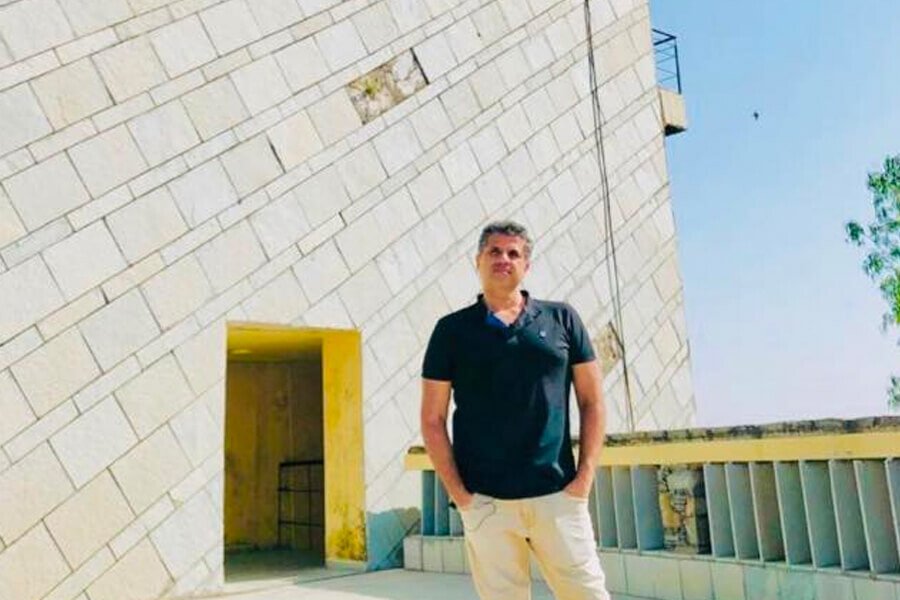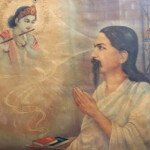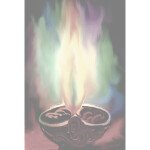The author at the feet of Maharana Pratap at the memorial in Dewair, Mewar
If we search Dewair on Google, what pops up is the second battle of Dewair between Rana Amar Singh of Mewar and Mughal oppressor Jehangir, in which Rana defeats the Mughals.
But the real battle that changed the course of history in the Indian subcontinent was the first battle of Dewair fought between Maharana Pratap of Mewar and forces of Mughal infiltrator Akbar in which Pratap conclusively defeated the Mughals. 36,000 Mughal troops were slaughtered in a day and the entire battlement of Mughals was decimated.
This piece isn’t about the facts of that great battle but an attempt to find reasons for the omission of a critical Battle like Dewair from education curricula, history courses and the public life of our nation. Why did the Leftist historians and the self-proclaimed intelligentsia of India remove this vital event from the collective consciousness of the nation?
Let us attempt to establish the historicity of Battle of Dewair by connecting few historical events and comments from eminent historians of Mewar.
Firstly, the British historian, Col. James Tod, writes in his phenomenal work ‘Annals and antiquities of Rajasthan' that Dewair was the place where Rajputs conclusively defeated Akbar. Tod has written an immortal aphorism comparing the battles of Mewar with the Mughals with the Greeko Persian conflict. In the Battle of Thermopylae, the Spartans, hopelessly outnumbered by the Persians, fought valiantly and in the Battle of Marathon, the Greeks defeated the Persians convincingly and conclusively.
Tod writes thus: Huldighati is the Thermopylae of Mewar; the field of Dewair her Marathon.
Tod continues, “Pratap surprised Shahbaz Khan at Dewair, whose troops were cut into pieces. The fugitives were pursued to Amait, the garrison of which shared the same fate. Ere they would recover from their consternation, Komulmer was assaulted and taken; Abdoola and his garrison were put to the sword and thirty two fortified posts in like manner carried by surprise, the troops being put to death without mercy.
Pratap made a desert of Mewar.
All except Chittor and Mandalgarh were recovered by Pratap. Udaipur was regained without a fight as the Mughals ran away."
Secondly, Dewair is the battle for which the great Bhama Shah gave his entire life’s earnings to Pratap and funded his army. Bhama Shah has been immortalised in the folklore of Mewar and the Leftists couldn’t erase him, but mysteriously, they managed to conceal the battle that was funded by him.
Thirdly, the very famous incident of Pratap slicing the Mughal general Bahlol Khan into two along with his horse happened on the fields of Dewair. This incident has been verified by different authors.
Fourthly, Dewair has been repeatedly mentioned in fair detail by various historians over a scattered frame of time. Besides Tod, the Telugu historian Ranchod Bhatt Telang has given exquisite details in two of his books: Raj Prashasti and Amar Kavya. In the late 19th century, Kaviraja Shyamlal Das wrote the ‘Veer Vinod' detailing Dewair.
The date of the Battle of Dewair: Vijaydashmi, 16th September, 1583.
The result of the battle: Mewar won conclusively with 84 garrisons and 36 check posts of Mughals decimated. Kumbhalgarh was regained by Pratap and, barring Chittor and Mandalgarh, Mewar was in full control of Pratap — Raj Prashasti.
Several modern day historians have also written on and documented Dewair. Dr. Gopinath Sharma, professor of history at Rajasthan University writes: Dewair’s take over was the brightest spot in Pratap’s life. Where Haldi Ghati was a challenge of morality and fortitude of the Rajputs, Dewair was decisive.
Pratap establishes firm control of Mewar after winning Dewair and the Mughal army was totally demoralized. The blood of the Rajputs slain at Haldi Ghati was avenged at Dewair.
After examining these evidences, if we look at the whole issue with a linear logic, then the battle of Dewair indeed appears to be the turning point in the incessant Hindu Muslim conflict in the Indian subcontinent. As has been taught to us in schools and colleges, if Haldi Ghati was the only battle that Pratap fought and lost, then how did Hinduism survive in India? If Pratap spent his life as a fugitive with occasional guerrilla attacks on the Mughals, how come there are coins bearing Pratap’s name in Mewar and papers with Pratap’s seal to land owners in Mewar?
Dewair laid the grounds for the army of Mewar to be equipped with vigor and resources such that the coming generations of Amar Singh and Raj Singh defeated Jehangir and Aurangzeb respectively.
Then why has Dewair been concealed from our collective consciousness? Why is it that such an important event finds no mention in NCERT books? Why has Pratap’s valor and love for independence been diluted and he is shown as a defeated warrior in Mewar? Instead of depicting Mewar, and her courageous people, as an independent sovereign state, why was it shown as a mere rebel to the Mughals? We will need to investigate these burning questions and arrive at our own conclusions, lest we forget and disown our own glorious past.
The first obvious possibility sprouts from the fact that post-independence, from 1947 to 1977, four Muslims, Maulana Abul Kalam, Nurul Hassan, Fakruddin Ali Ahmed and Humayun Kabeer were education ministers of the Indian union. Were these leaders serving their faith more than the nation in deliberately pushing the entire history of Mewar under the carpet?
Unfortunately, the reins of independent India went into the hands of a self-proclaimed Leftist, Jawaharlal Nehru, who outsourced writing our history to hard core Leftists like Romila Thapar and Irfan Habib, writers with doubtful integrity and scholarship.
Was reducing the bravery of Mewar to a mere foot note in history and eulogizing foreign invaders only a ploy to fill the Hindus with an inferiority complex?
Secondly, a civilizational lie created by the entire Left has been that Hindus have been slaves for one thousand years. To maintain this lie, it was crucial that the victory saga of Hindus and the defeats of Islamic invaders were deleted from our history.
Hence, not only battles like Dewair, but even the mention of warriors like Bappa Rawal, Prithviraj Chauhan, Raja Lachit of Assam, Durgadas Rathore, Chatrapati Shivaji, or the kingdoms like Vijaynagar and the Maratha empire have all been relegated or simply erased from the history of our nation.
Very surreptitiously, the historians of this nation only refer to Islamic historians like Abul Fazal or Al Badayuni who have a distinct bent for their masters while contemporary Hindu historians and authors are completely ignored although dozens of Indian historians have done exhaustive work on the Battle of Dewair and the Maharanas of Mewar.
The third reason for relegating the historic victories of Mewar could be an alliance of Islamic theologists with the Leftists and the Indian National Congress because what Islamic expansionism couldn’t achieve by the sword, it set out to achieve by deceit. What better way to deceive the masses of this nation than to lull them into submission to their faith by destroying crucial evidence of the pushback of our great ancestors against this very encroachment being attempted for centuries!
This makes it critical for Indian society to revive the memories of events like Dewair and to establish truth very objectively and dispassionately. Only then can the Hindu Samaj be jolted out of the stupor it has been pushed into by decades of Leftist propaganda. Only then can the future generations of Indians understand that the Hindus were not enslaved for even a minute by the medieval intruders, leave alone a thousand years.
We must remember that Islam converted Mesopotamia to Iraq, Persia to Iran and overran Egypt and the entire Middle East in a span of few decades but Islam’s progress was halted in India and that fact doesn’t sit well with many fundamentalists and Leftists in this nation. They are baffled by the fact that starting from Mohd. Bin Qasim’s attack on Raja Dahir of Sindh, in the seventh century, and even after 1400 years of relentless attacks on India, there are still a hundred crore Hindus thriving in India and Sanatana Dharma pulsates in India with full vigor.
Dozens of libraries like Nalanda were burnt and eight crore Hindus slaughtered (source: Will Durant) but still the Brahmins of this country kept the Hindu scriptures alive through verbal transmission called ‘Shruti’ over generations. Leaders of the mercantile class, like Bhama Shah, gave up their entire life’s earnings to fund armies across Bhaarat, the Kshatriyas turned the streets of this nation red with their blood to protect the honor of their women and Kuldevis, and the lowest in the social ladder, the Bheels, aligned with the ruling class and fought and defeated the invaders.
Eminent historian, Prof. K.S. Gupta of Sukhadia University, Udaipur, says that Dewair is a milestone in the Hindu Muslim conflict in the subcontinent because after Bappa Rawal, Pratap was the first king to go on an offensive and attack the garrison at Dewair. Before this, almost all Hindu kings were on the defensive against the invaders.
In all civilised societies, a historian’s dharma is to find facts and preserve them for future generations and for those who were themselves not present. The readers of history trust the historians and accept what they tell him as the truth. But if the historians themselves are corrupt, dishonest and lack integrity, or their world view is skewed by their ideology, then they will convey lies to the reader, and the reader will treat those lies as truths and will act on them, will come to harm and grief, and in extreme cases, even to destruction.
The Leftists actually believe that it is moral to lie in order to advance their philosophy. As a result, the unsuspecting reader gets fed with lies which act like poison that destroys, slowly or quickly. Honesty and integrity are the core values of life and anything that sanctions lies is anti-life, and will always destroy life.
The erasure of Dewair and the valor of the Maharanas of Mewar is treachery of the worst kind with Hindus in general and the academic scholarship in particular, and these must be corrected. If India has to fight radical terrorism then we have to be free of this inferiority complex instilled into our psyches by the Leftist ecosystem because only the names and faces have changed, the same civilizational conflict is being played out brazenly in the subcontinent. We cannot fight the passion and fervor that radical religions generate but we have to find a matching narrative to evoke a similar zeal amongst those who live for Dharma. Only when we rise as a nation, equipped with the knowledge that our glorious forefathers fought the forces and agents of bigotry with bare hands and raw guts, will we be proud of Maharana Pratap and his victories and we will be eternally grateful to the Rajputs, the Baniyas, the Brahmins and the Bheels of Mewar who fought for and defended our Dharma.
We must reject those bigots masquerading as historians who concealed the truth from us by serving us half baked stories and made a mockery of our trust in them. The Tatars and the Turk invaders were made to bite the dust by Pratap and his lineage, and as a consequence of that, the Hindus are still standing up to Islamic expansionism even today.
Adharma has to be resisted at all costs. That is the central message of Yogeshwara Sri Krishna in the Geeta. Our valorous ancestors did exactly that. Are we ready to give our ahuti, our contribution, to that Mahayagya of Dharma?
Col. Tod, comparing British history with the warriors of Mewar, writes: How did the Britons at once sink under the Romans, and in vain strive to save their groves, their druids, or the altars of Bal from destruction! To the Saxons they alike succumbed; they, again, to the Danes; and this heterogeneous breed to the Normans. Empire was lost and gained by a single battle, and the laws and religion of the conquered merged in those of the conquerors. Contrast with these the Rajputs; not an iota of their religion or customs have they lost, though many a foot of land. Some of their States have been expunged from the map of dominion; and, as a punishment of national infidelity, the pride of the Rathor, and the glory of the Chalukya, the overgrown Kanauj and gorgeous Anhilwara, are forgotten names! Mewar alone, the sacred bulwark of religion, never compromised her honour for her safety, and still survives her ancient limits; and since the brave Samarsi gave up his life, the blood of her princes has flowed in copious streams for the maintenance of this honour, religion, and independence.”
Today, when we have the financial resources, the numbers and a sensitive power structure in India, equipped with the internet and a modern communications network, what can prevent us from establishing a just and prosperous Hindu Rashtra for all citizens of this amazing nation!
When we will pause and look back at this 1400 year old struggle to establish Dharma and Satya, Dewair will be that pious memory which will remind us of the bravery and sacrifice of all of Mewar under the leadership of Pratap.










